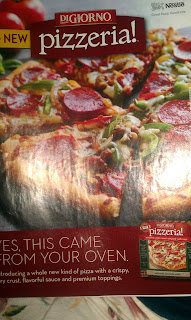I found this ad in a People magazine. The first thing that caught my eye was the pizza itself, which I thought was the point. The large picture is an appeal the the need for physiological needs. I know the glare gets in the way, but that is a fine looking pizza.
Immediately under the picture is a block of text, which assures the customer that they can get this in their own home. In a way, the text also uses "avante garde," because it's the newest thing in the frozen pizza department. The ad points out that it's new in two places, so DiGiorno really wants the customer to remember that this is a new product, and it's a "whole new kind of pizza." Now, I've had pizza with a crispy crust, flavorful sauce, and premium toppings, so I don't quite understand how it's different from all other pizzas. However, it says it's new, so I have to believe it, right? But these "new" features are also a use of "magic ingredients," because that's what makes it special.
Overall, it's a pretty simple ad, but there are subtle details. They included a picture of the box so that when you're shopping late at night, you see the ad and thing, "Hey, that's a new kind of pizza! It has flavorful sauce!" and then you buy it and DiGiorno makes money. I also noticed that they made the color scheme look like pizza. The red that the text is on and the red logo is reminiscent of a pizza. It's all connected. Genius. I also thought it was interesting that the biggest text on the ad is "pizzeria!" with an exclamation point and no capitalization. Maybe they want you to think that buying this pizza will turn your house into a pizzeria, which would be a use of "transfer/association," or if they wanted to make the pizza seem more authentic, but they want you to pay attention to that word. There's also the light-colored Nestle logo in the corner. I thought they might have included that because Nestle is a generally credible company, but I'm not sure. Overall, I thought it was pleasing to look at, and I believe that's what DiGiorno was going for.




